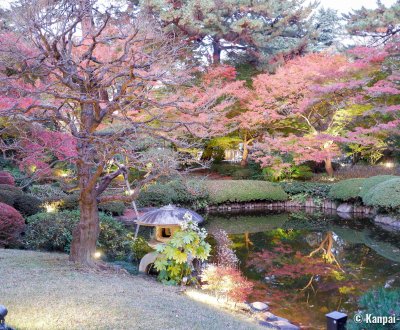Shirokanedai
Green Wealthy Neighborhood in the South of Tokyo
Shirokanedai is a refined and discreet area, located at the southwestern end of Minato ward in the center of Tokyo. Since the Edo period, this green residential neighborhood has been home to well-off notabilities’ elegant estates, some of which are now museums and gardens open to the public.
Tokyo’s Shirokanedai neighborhood was named after the moniker Shirokane Choja (白金長者) given to Kazusanosuke Yagishita, an officeholder at the Imperial Court during the Oei period (1394 – 1428). His nickname means "platinum millionaire" and reflects his wealth after he amassed a vast fortune in silver, an ore that was also named "white gold" or shirokane in Japanese.
As it was close to the power center of Chiyoda, Shirokanedai’s urban and wooded district used to be the living quarters of daimyo lords during the Edo period (1603 – 1868), later replaced by wealthy industrialists and after WWII, it also stated to accommodate well-off international residents.
Shirokanedai and the adjoining Shirokane are 2 small areas of Tokyo known for being a classy place where it feels good to live. Standing apartments, as well as prestigious schools and one campus of Meiji Gakuin university compose the cityscape, whose refined and discreet charm is better enjoyed strolling in the streets while discovering a few of its touristic sites.

Gaien Nishi-dori: the main avenue lined with ginkgo trees
Shops and restaurants are gathered around Shirokanedai’s main avenue, the Gaien Nishi-dori, which is also called "Platinum Street" (プラチナ通り Purachina-dori in Japanese). Most of the shops are on the luxury side and / or international brands, but the surroundings of the subway 🚇 station have more popular stores such as a Don Quijote and a 100 Yen 💴 shop.
The avenue’s gentle slope is lined with dozens of ginkgo bilobas whose golden foliage embellish the scenery in autumn 🍁, the ideal season for rambling in the area.

Japanese gardens and museums
Other places to see are former private or imperial estates converted into history and art museums for the public, such as:
- Happo-en, a large and luxurious garden, with a reputation for hosting private events such as weddings or upscale cocktail parties. It is particularly beautiful in autumn when its koyo are illuminated at night;
- The Tokyo Metropolitan Teien Art Museum, housed in the former residence of Prince Asaka (1887 - 1981) and that welcomed its 40th anniversary in 2024. Its building displays an Art Deco architecture, and is surrounded by a Western-style garden and a Japanese style garden with a tea house nestled in its vegetation;
- The Institute for Nature Study, that looks like a forest hidden in the heart of Tokyo, very different from the usually sophisticated scenery of traditional gardens. This open-air giant plant nursery is home to ancient zelkovas and Japanese black pines. Its construction started during the Edo period, and after a while it became an imperial property called Kyu Shirogane Goryochi. It was finally bequeathed to Ueno’s National Museum of Nature and Science that is still maintaining it today; and,
- Minato City Local History Museum, inaugurated in 2018 in a large building constructed for a public health institute in 1938. Its red Brick Gothic front was designed by architect Yoshikazu Uchida (1885 - 1974) who also created buildings in the same style for Todai.

Located near Meguro’s cherry tree 🌸 River and Ebisu’s shopping malls, Shirokanedai is one of the historical and elegant neighborhoods of the capital, like Azabu a few kilometers away.

